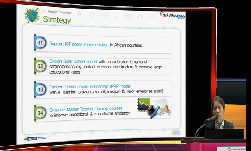This study presents an experimental analogue of resistance in the consultation process. Using a reversal design, the experimenter measured the ecological effects of teacher resistant behaviors on consultant therapeutic behavior. The study defined the...
http://chineseinput.net/에서 pinyin(병음)방식으로 중국어를 변환할 수 있습니다.
변환된 중국어를 복사하여 사용하시면 됩니다.
- 中文 을 입력하시려면 zhongwen을 입력하시고 space를누르시면됩니다.
- 北京 을 입력하시려면 beijing을 입력하시고 space를 누르시면 됩니다.
Resistance is not futile: An experimental analogue of "resistance" effects on the consultant's therapeutic behavior in the treatment of disruptive students.
한글로보기https://www.riss.kr/link?id=T10748092
- 저자
-
발행사항
[S.l.]: Temple University 2005
-
학위수여대학
Temple University
-
수여연도
2005
-
작성언어
영어
- 주제어
-
학위
Ph.D.
-
페이지수
97 p.
-
지도교수/심사위원
Adviser: T. Chris Tillman.
-
0
상세조회 -
0
다운로드
부가정보
다국어 초록 (Multilingual Abstract)
The team consisting of the experimenter and teacher met weekly to discuss the previous sessions data and what do in the next session. The experimenter instructed the teachers on the type of session that they were supposed to provide: when to be resistant and when to be nonresistant in the study. When a stable baseline occurred, the experimenter instructed the teachers to become resistant. The resistance continued for several (3-4) active sessions. After this phase, the experimenter instructed the teachers to become compliant again for several (3-4) sessions. When the experimenter observed stability in the data, the experimenter instructed the teachers to become resistant until the end of the study (between 2-3 sessions). The experimenter measured intervention integrity by coding teachers' behaviors to determine if they were resistant in resistant phases and not resistant in the nonresistant phases. At the end of each session, consultants coded their overall rating of their beliefs of the teacher's skill level, warmth, and ability.
It is clear that in the A phases of intervention, the participants emitted more therapeutic statements than during the B phases. In addition, looking at the participants' perception of their own effectiveness as consultants and their perception of the warmth and competence of consultees' behavior, the participants were more confident in themselves and rated the consultees as more effective in the A phases than in the B phases.
The data supports the notion that the intervention affected the participants' number of therapeutic statements. We found that all participants decreased therapeutic questioning in response to consultees' resistance. In addition, the resistance also led to increased number of missed sessions by the participants and greater negative perceptions of the consultees by the participants. (Abstract shortened by UMI.).
This study presents an experimental analogue of resistance in the consultation process. Using a reversal design, the experimenter measured the ecological effects of teacher resistant behaviors on consultant therapeutic behavior. The study defined therapeutic behaviors as teaching, confronting and problem identification, analysis, and evaluation statements as outlined by Bergan and Kratochwill (1990). In this study, the author instructed four school psychology students and one student from a masters program in behavior analysis that this was a study of resistance in the consultation process with teachers. The experimenter instructed the participants that analysis of the sessions would determine if any resistance occurred and how they managed it. The teacher was a double agent, in the sense that s/he was working with the experimenter. The study measured participants' behavior on therapeutic statements made to the teachers during varying levels of resistant statements made by teachers. The experimenter met with teachers on weekly basis. Overall, the participants had between 12-15 sessions (variation due to missed sessions by the consultant) with the teacher.
The team consisting of the experimenter and teacher met weekly to discuss the previous sessions data and what do in the next session. The experimenter instructed the teachers on the type of session that they were supposed to provide: when to be resistant and when to be nonresistant in the study. When a stable baseline occurred, the experimenter instructed the teachers to become resistant. The resistance continued for several (3-4) active sessions. After this phase, the experimenter instructed the teachers to become compliant again for several (3-4) sessions. When the experimenter observed stability in the data, the experimenter instructed the teachers to become resistant until the end of the study (between 2-3 sessions). The experimenter measured intervention integrity by coding teachers' behaviors to determine if they were resistant in resistant phases and not resistant in the nonresistant phases. At the end of each session, consultants coded their overall rating of their beliefs of the teacher's skill level, warmth, and ability.
It is clear that in the A phases of intervention, the participants emitted more therapeutic statements than during the B phases. In addition, looking at the participants' perception of their own effectiveness as consultants and their perception of the warmth and competence of consultees' behavior, the participants were more confident in themselves and rated the consultees as more effective in the A phases than in the B phases.
The data supports the notion that the intervention affected the participants' number of therapeutic statements. We found that all participants decreased therapeutic questioning in response to consultees' resistance. In addition, the resistance also led to increased number of missed sessions by the participants and greater negative perceptions of the consultees by the participants. (Abstract shortened by UMI.).










